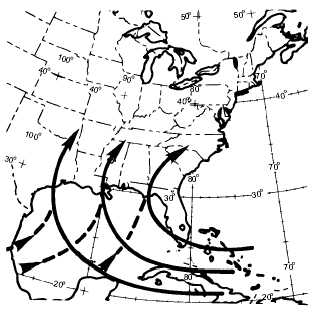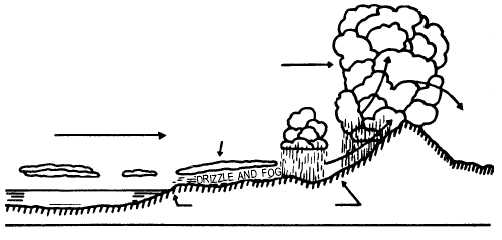and Gulf of Mexico (fig. 4-11), mild temperatures, high
humidities, and cloudiness are found, especially during
the night and early morning. This is the characteristic
weather found in mT air in the absence of frontal
conditions. The stratus and stratocumulus clouds that
form at night tend to dissipate during the middle of the
day and fair weather prevails. Visibility is generally
poor when the cloudiness is present; however, it
improves rapidly because of convective activity when
the stratus clouds dissipate. The ceilings associated
with the stratus condition generally range from 500 to
1,500 feet, and the tops are usually not higher than
3,500 to 4,500 feet. Precipitation does not occur in the
absence of frontal action. With frontal activity, the
convective instability inherent in this air is released,
producing copious precipitation.
If mT air is forced over mountainous terrain, as in
the eastern part of the United States, the conditional
instability of the air is released at higher levels. This
might
produce
thunderstorms
or
at
least
large
cumuliform clouds. (See fig. 4-12.) Pilots must be
aware that these clouds may develop out of stratiform
cloud systems and therefore may occur without
warning. Icing may also be present. Thus, in the Great
Lakes area, a combination of all three hazards (fog,
thunderstorms, and icing) is possible.
Occasionally when land has been cooled along the
coastal area in winter, maritime tropical air flowing
inland produces an advection fog over extensive areas.
(See fig. 4-13.) In general, flying conditions under this
situation
are
fair.
Ceilings
and
visibilities
are
occasionally below safe operating limits; however,
flying conditions are relatively smooth and icing
conditions are absent near the surface layers.
As the trajectory carries the mT air northward over
progressively colder ground, the surface layers cool and
become saturated. This cooling is greatly accelerated if
the surface is snow or ice covered or if the trajectory
carries the air over a cold-water surface. Depending on
the strength of the air mass, fog with light winds or a
low stratus deck with moderate to strong winds forms
rapidly because of surface cooling. Occasionally
drizzle falls from this cloud form; and visibility, even
with moderate winds, is poor. Frontal lifting of mT air
in winter, even after the surface layers have become
stabilized, results in copious precipitation in the form of
rain or snow.
4-12
AG5f0411
mT
mT
Figure 4-11.—Trajectories of mT air over the Atlantic in
winter.
WATER TEMP. 20 C.
O
GULF OF MEXICO
SW
NE
APPALACHIANS
AG5f0412
10 C. SURFACE TEMP. 0 C.
O
O
STRATUS
mT
CUMULONIMBUS
Figure 4-12.—mT air moving northeastward.




